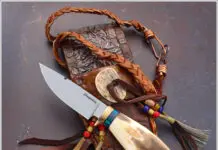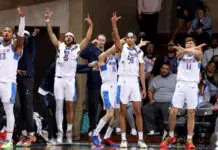In a state where football, basketball and softball dominate the sports scene, a water sport is making a big splash – and for evidence, one need look no farther than the north bank of the Oklahoma River.
Over the past two decades, the river – officially the North Canadian except for the seven-mile segment that runs past downtown – has been transformed into one of the world’s premier rowing venues, with four boathouses devoted to collegiate and international rowing competition. It has also given rise to a bevy of other competitive water sports and recreation opportunities, leading up to Oklahoma City’s selection as host site for the canoe slalom competition in the 2028 Olympics.
Mike Knopp, president of Riversport OKC and an avowed rowing enthusiast, was the first rowing coach at Oklahoma City University (OKCU), establishing rowing as a club program in 2001 before the program attained varsity status in 2004. Before coming to OKC, Knopp also established a club rowing program at Oklahoma State University. The club program at OSU is still going strong, and so are the varsity men’s and women’s programs at OKCU, now coached by Bryan Volpenhein.
Knopp recalls the Oklahoma River’s early days when someone described the river as little more than a trickle, so dry in places that a person could walk across it.
“What people didn’t know was that we were sitting on something that could be world-class,” he says.
At the same time, OKC civic leadership was putting together the first MAPS program, and Knopp says they included improvements to the river. The resulting Oklahoma River includes a 2,200-meter, 450-feet-wide straight section.
“We don’t want a real wide waterway, and we want it protected,” Knopp says. “When you look at it from top down it looks like an Olympic venue.”
Volpenhein – who coaches both the men’s and women’s rowing teams at OKCU – says he has 14 men and six women in this year’s program. He hopes to add four to six more rowers for the upcoming fall and spring seasons, and eventually grow the program to 30.
“We’re such a small school, we don’t have enough guys for an eight-man team right now,” says Volpenhein, a decorated Olympic rower who was part of the gold medal, eight-main team at the 2004 Athens Olympics.
Volpenhein says the fall season is devoted more to training, with racing competition primarily in the spring. He says he looks for athletes with “height and strength,” to form a team that can produce leverage and eventually add power.
“We’re mentally looking for people willing to work, and who enjoy the process,” he says. “You’re practicing year -round but only racing four or five times. We’re looking for kids who understand that and are willing to put in all the practice time for the payoff.”
It’s more common now for rowers to reach college age with at least some rowing experience, says Volpenhein. He, on the other hand, says he didn’t begin rowing until he reached college at Ohio State.
Collegiate rowers compete either in sweeps, where each rower has one oar, or skulling, where rowers have two oars each. Crews have either four or eight members.
Volpenhein says some training is done indoors at OKCU using rowing machines when the weather makes outdoor training impossible.
Sarah Gehrke manages the under-17 juniors rowing program for OKC’s Riversport. She says the program currently has 60 to 70 high school athletes, with another 50 to 60 middle schoolers participating. Some athletes join the program as seniors.
From last year’s senior class, about a dozen were recruited to college programs.
“The great thing about rowing is you can join at any point,” she said. “The earlier you can join, the better.”
Main image cutline: Oklahoma City University has a men’s and women’s rowing team, both helmed by coach Bryan Volpenhein, an Olympic gold medalist. Photo courtesy OKCU






















